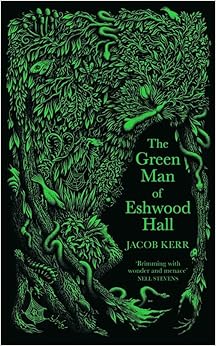The Green Man of Eshwood Hall by Jacob Kerr
Set in 1962, the story begins with the Whipper family arriving at Eshwood Hall, a crumbling 18th century manor house at which Ray Whipper has taken a live-in job as a driver and handyman for its elderly, largely bedbound owner. He's accompanied by his wife Gerry, his daughters Izzy and Annie, and his baby son Raymond, known as the Bairn.
We're told by the omniscient narrator that this is to be the story of Izzy, aged 13, and Gerry, as well as the mysterious and nameless Green Man of the title. It's fair to say, though, that Izzy is certainly our main protagonist, and it's with Izzy that our sympathies lie, because it soon becomes clear that her parents are negligent at best (Ray) and abusive at worst (Gerry). She's forbidden to go to school and effectively treated as a servant, with the excuse being that Gerry has a weak heart and can't do much physically, although it seems pretty obvious that Gerry is a manipulative, self-absorbed hypochondriac. The Bairn, as a baby and her only son, is the only child she's really interested in, although she still expects Izzy to provide much of his care and her main interest is her collection of china figurines. Ray is more affable, but it seems he's as wary of Gerry as the rest of the family, and at no point sees fit to address his wife's cruel, coercive parenting, preferring to focus on his quixotic pastime of trying to patent his bizarre, pointless inventions.
Small wonder, then, that Izzy's perception of the world, and her sense of her place in it, is out of kilter - and small wonder too that bringing this lonely adolescent to an isolated, decaying house, where past tragedies pervade every brick and beam, and strange noises occur in the night, is the start of a dangerous downward spiral. The more time Izzy spends wandering in the overgrown woods that form the hall's grounds, the more she becomes drawn into the ancient history and folklore that has shaped the place, and the more it draws her in.
The Green Man, in English folklore, is a symbol of rebirth, a figure who appears in the spring to bring new life and fertility as new leaves appear on bare branches, and the green shoots of plants emerge from the dormancy of winter. Izzy, at the start of her adolescence and miserably trapped in a stagnant family from which nothing positive ever seems to emerge, is understandably susceptible to everything the Green Man signifies and offers. But of course, for rebirth to occur, something has to die first.
The Green Man of Eshwood Hall is extremely well-written, and gives Izzy a convincing and vivid voice. It leaves a lot unsaid, which allows for an ambiguity of interpretation, and this adds to the unsettling, uncertain atmosphere that pervades the story. It is a creepy piece of folk horror, but first and foremost it's a family tragedy with a deeply vulnerable protagonist and a powerful sense of history and place.

Comments
Post a Comment